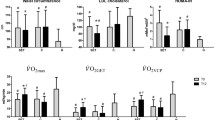Abstract
Objective: To establish whether patients receiving the cholesterol synthesis enzyme inhibitor fluvastatin 20 mg/day could obtain an additional improvement in their lipid pattern as a result of physical endurance training.
Design: This was an observational study using a before- and after-treatment comparison of fitness and lipid parameters in outpatients with dyslipidaemia who undertook an exercise programme with or without treatment with a lipid-lowering drug.
Study participants: Participants were 18 sedentary [maximum oxygen uptake (V̇O2max) <30 ml/kg bodyweight per minute] men (age range 38 to 65 years) with dyslipidaemia but without overt cardiovascular disease.
Interventions: All participants undertook a 1-hour bout of endurance training twice a week for 3 months. The training involved a circuit using various ergometers, with continuous monitoring of pulse rate, at an exercise intensity of 2 to 3 mmol/L lactate. The control group (n = 6) received no drug treatment; they completed the training programme only. The pretreatment group (n = 6) comprised participants who had already been treated with fluvastatin 20 mg/day for at least 3 months before beginning the training programme. The treatment group (n = 6) received fluvastatin 20 mg/day from the beginning of the training programme. All participants were required to comply with the exercise programme and with a standardised carbohydrate-loaded diet together with restriction of alcohol consumption to a maximum of 20 ml/day.
Results: In the control group, increased physical activity alone reduced serum triglyceride (TG) levels (−24.7%) and increased serum high density lipoproteincholesterol (HDL-C) levels (+19.3%). There was a smaller effect on serum low density lipoprotein-cholesterol (LDL-C) levels (−12.8%). Similar but smaller effects were observed in the pretreatment group (i.e. patients previously treated with fluvastatin): TG −12.88%, HDL-C +13.81%, LDL-C −8.7%. Marked changes were observed in the treatment group: TG −33.1%, HDL-C +34.7%, LDL−C −40.5%, total cholesterol −30.5%.
Conclusions: A reduction of serum LDL-C level in the target range of −30 to −40% cannot be achieved by this intensity of training alone. In combination with fluvastatin 20 mg/day, however, the positive effects on lipid metabolism are potentiated. Thus, treatment with fluvastatin combined with moderate endurance training is a rational mode of therapy, particularly in patients with a highly pathological lipid profile.
Similar content being viewed by others
References
Blair SN, Kohl MW, Pfaffenberger RS. Physical fitness and all-cause mortality: a prospective study of healthy men and women. JAMA 1989; 262: 2395–401
Lakka TA, Venäläinen JM, Ranramaa R. Relation of leisure-time activity and cardio-respiratory fitness to the risk of acute myocardial infarction in men. N Engl J Med 1994; 330: 1549–54
Pfaffenberger Jr RS, Hyde RT, Wing AL. The association of changes in physical activity level and other lifestyle characteristics with mortality among men. N Engl J Med 1993; 328: 538–45
Hambrecht RJ, Niebauer Ch, Marburger M. Various intensities of leisure time physical activity in patients with coronary artery disease: effects on cardiorespiratory fitness and progression of coronary atherosclerotic lesions. J Am Coll Cardiol 1993; 22: 468–77
Berg A, Frey J, Baumstark MW. Physical activity and lipoprotein lipid disorders. Sports Med 1994; 17: 6–21
Haskell WL. The influence of exercise training on plasma lipids and lipoproteins in health and disease. Acta Med Scand 1985; 711: 25–37
Baumstark MW, Frey J, Berg A. Acute and delayed effects of prolonged exercise on serum lipoproteins: concentration and composition of low density lipoproteins subfraction and very low density lipoproteins. Eur J Appl Physiol 1993; 66: 526–30
Dufaux B, Liesen H, Rost R, et al. Über den Einflu eines Ausdauertrainings auf die Serumlipoproteine unter Berücksichtigung des HDL-Cholesterins bei jungen und älteren Personen. Deutsche Z Sportmedizin 1979; 30 (5): 123–8
Schulte K-L, Beil S. Efficacy and tolerability of fluvastatin and simvastatin in hypercholesterolaemic patients. Clin Drug Invest 1996; 12 (3): 119–26
Haasis R, Berger J. Fluvastatin versus Lovastatin: Effektivität und Sicherheit einer Lipidsenkung. Z Kardiol Angiol 1995; 27: 375–80
Fachinformation über Fluvastatin (Cranoc®) [Prescribing information for fluvastatin]. Herausgeber: Bundesverband der pharmazeutischen Industrie. Hamburg-Wedel (Germany): Astra GmbH, 1998
Dufaux B. Plasmalipoproteinveränderungen nach körperlicher Belastung und Training. Cologne: Habilitationsscchrift aus dem Institut für Sportmedizin der Deutschen Sporthochscule Köln, 1984: 25–7
Niesten-Dietrich U, Simon G, Blome G, et al. The effects of walking, running and powertraining on lipid metabolism. Deutsche Z Sportmedizin 1994; 45 (1): 18–29
Fritz K. Effects of exercise on high density lipoproteins and other lipoproteins. Lipid Disord 1987; 5: 23–31
Huttunnen JK, Lansimies W, Voutilainen F. Effect of moderate physical exercise on serum high density lipoproteins. Circulation 1979; 60: 1200–9
Weicker H, Strobel G. Biochemische-physiologische Grundlagen und ihre sportartspezifische Bedeutung. Stuttgart: Gustav-Fischer-Verlag, 1994: 141–7
Berg A, Halle M, Baumstark MW, et al. Die Bedeutung der Lipoproteine bei der Pathogenese der KHK: Die Rolle der körperlichen Aktivitä. Deutsches Ärzteblatt 1991; 12 (3/94): 822–30
Heyden S. Zur HDL-Epidemiologie: körperliche Aktivität, ein Co-Faktor? Deutsche Z Sportmedizin 1993; 44 (10): 504–6
Windler E, Klose G, Greten H. Lipide und KHK: Standort präventiver Strategien. Munch Med Wochenschr 1997; 139: 3–8
Author information
Authors and Affiliations
Rights and permissions
About this article
Cite this article
Wittke, R. Effect of Fluvastatin in Combination with Moderate Endurance Training on Parameters of Lipid Metabolism. Sports Med 27, 329–335 (1999). https://doi.org/10.2165/00007256-199927050-00004
Published:
Issue Date:
DOI: https://doi.org/10.2165/00007256-199927050-00004




